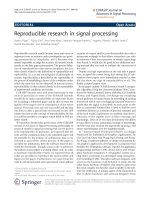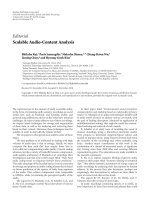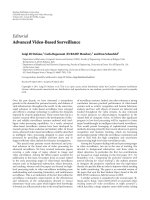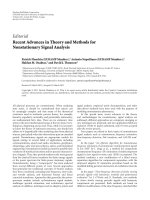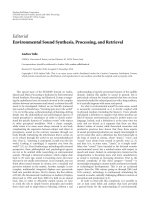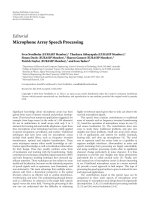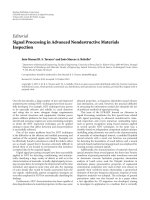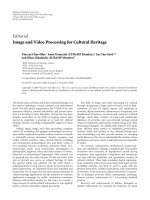Báo cáo hóa học: " Editorial Embedded Digital Signal Processing Systems" potx
Bạn đang xem bản rút gọn của tài liệu. Xem và tải ngay bản đầy đủ của tài liệu tại đây (417.95 KB, 1 trang )
Hindawi Publishing Corporation
EURASIP Journal on Embedded Systems
Volume 2007, Article ID 27517, 1 page
doi:10.1155/2007/27517
Editorial
Embedded Digital Signal Processing Systems
Jarmo Takala,
1
Shuvra S. Bhattacharyya,
2
and Gang Qu
2
1
Institute of Digital and Computer Systems, Tampere University of Technology, Korkeakoulunkatu 1, 33720 Tampere, Finland
2
Department of Electrical and Computer Engineering, University of Maryland, College Park, MD 20742, USA
Received 6 March 2007; Accepted 6 March 2007
Copyright © 2007 Jarmo Takala et al. This is an open access article distributed under the Creative Commons Attribution License,
which permits unrestricted use, distribution, and reproduction in any medium, provided the original work is properly cited.
With continuing progress in VLSI and ASIC technologies,
digital signal processing (DSP) algorithms have continued
to find great use in increasingly wide application areas. DSP
has gained popularit y also in embedded systems although
these systems set challenging constraints for implementa-
tions. Embedded systems contain limited resources, thus em-
bedded DSP systems must balance tradeoffs between the re-
quirements on computational power and computational re-
sources. Energy efficiency has been important in battery-
powered devices, but nowadays also the limited heat dissi-
pation in small devices calls for low-power consumption.
Successful implementation of DSP applications in embedded
systems requires tailoring, which in turn sets challenges for
design methodologies.
For this special issue, we received 14 submissions and a
collection of seven papers was finally accepted. The special
issue is opened by “Observations on power-efficiency trends in
mobile communication devices ,” where the authors O. Silv
´
en
and K. Jyrkk
¨
a analyze the power consumption in the cur-
rent mobile communication devices. Several bottlenecks in
the current implementation style have been identified, thus
the paper provides a good motivation for the following pa-
pers.
In “The Sandbridge SB3011 plat form,” the authors John
Glossner et al. describe a system-on-a-chip (SoC) multipro-
cessor targeted as a software-defined radio platform. The
platform provides solutions to the challenges in future mo-
bile devices given in the previous paper.
“A shared memory module for asynchronous arrays of pro-
cessors” authored by Michael J. Meeuwsen et al. considers also
chip multiprocessors. The presented shared memory module
can b e used for interprocess communication or to increase
application performance by parallelizing computation.
In “Implementing a WLAN video terminal using UML
and fully automated design flow” by Petri Kukkala et al., an
automated design flow for multiprocessor SoC is presented.
The flow is based on UML descriptions and the authors
demonstrate their design flow with a design case.
Programming of chip multiprocessor platforms is con-
sideredin“pn: a tool for improved derivation of process net-
works” by Sven Verdoolaege et al. The paper discusses con-
version of sequential programs to process networks allowing
optimization of communication channels and buffers.
In “A SystemC-based design methodology for digital signal
processing systems,” the authors Christian Haubelt et al. de-
scribe a design flow for SoC designs containing automatic
design space exploration, performance evaluation, and auto-
matic platform-based system generation. The design flow is
based on SystemC descriptions and the presented tools can
automatically detect the underlying model of computation.
Application-specific implementations are often used
to speedup certain DSP tasks in embedded systems. In
“Priority-based heading one detector in H.264/AVC decoding,”
the authors Ke Xu et al. consider such implementations to
speed up video decoding applications. The authors present
a low-power decoder implementation for context-adaptive
variable length coding defined in H.264 standard.
Jarmo Takala
Shuvra S. Bhattacharyya
Gang Qu

